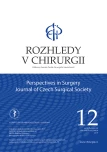Extraperitoneal pocket splenopexy is a suitable solution for wandering spleen in children and adolescents – case report
Authors:
B. Frýbová; V. Dotlačil; M. Rygl
Authors‘ workplace:
Klinika dětské chirurgie 2. lékařské fakulty Univerzity Karlovy a Fakultní nemocnice v Motole
Published in:
Rozhl. Chir., 2019, roč. 98, č. 12, s. 509-512.
Category:
Case Report
doi:
https://doi.org/10.33699/PIS.2019.98.12.509–512
Overview
Introduction: Wandering spleen is a rare cause of recurrent abdominal pain in children that is difficult to diagnose. Splenopexy should be preferred to splenectomy.
Case report: The patient, a 4 years old girl on growth hormone therapy, was referred to the Department of Paediatric Surgery for an assessment of episodes of abdominal colic and frequent vomiting. Sonography did not indicate any pathology, gastrointestinal contrast study showed an altered shape of the gastric outlet, and upper endoscopy diagnosed a prepyloric membrane. Open surgery was indicated based on these examinations, revealing a large wandering spleen and dilated stomach and small bowel loops oppressed by the long splenic suspensory ligaments. Pyloroplasty was performed with the antral membrane excision and shortening of the long gastrosplenic ligament and placement of the spleen into the left hypochondrium. No complications occurred in the postoperative period. Four months later the patient was hospitalised again for abdominal colic pain. Surgical revision of the abdomen revealed the wandering spleen in the mesogastrium. Even though the spleen was the cause of the second surgery, we decided to preserve the spleen. Partial splenectomy was done, fixing the large spleen into an extraperitoneal pocket in the left hypochondrium. The postoperative course was uneventful. Blood flow to the spleen is regularly monitored by Doppler ultrasound. Vaccination was indicated at the office of haematology according to the scheme for splenectomy patients; however, prophylactic antibiotic therapy was not needed given the good function of the preserved part of the spleen.
Conclusion: Extraperitoneal fixation of the spleen seems to be a good choice for patients with a wandering spleen, particularly for children and adolescents.
Keywords:
Wandering spleen – extraperitoneal fixation of the spleen – relapsing abdominal pain in children
Sources
- Fukuzawa H, Urushihara N, Ogura K, et al. Laparoscopic splenopexy for wandering spleen: extraperitoneal pocket splenopexy. Pediatr Surg Int. 2006;22:931–4. 10.1007/s00383-006-1760-2.
- Steinberg R, Karmazyn B, Dlugy E, et al. Clinical presentation of wandering spleen. J Pediatr Surg. 2002;37:E30. doi:10.1053/jpsu.2002.35443.
- Alqadi GO, Saxena AK. Is laparoscopic approach for wandering spleen in children an option? J Minim Access Surg. 2018. [On-line]. doi:10.4103/jmas
- Jones BJ, Daly M, Delaney PV, et al. Torsion of the spleen managed by splenopexy. Br J Surg. 1991;78:887–8. doi:10.1002/bjs.1800780737
- Schmidt SP, Andrew HG, White JJ. The splenic snood: an improved approach for the management of the wandering spleen. J Pediatr Surg. 1992; 27:1043–4. doi:10.1016/0022-3468(92)90555-l.
- Seashore JH, Mcintosh S. Elective Splenopexy for wandering spleen. J Pediatr Surg. 1990; 25:270–2. doi:10.1016/0022-3468(90)90438-F.
- Nomura H, Haji S, Kuroda D, et al. Laparoscopic splenopexy for adult wandering spleen: sandwich method with two sheets of absorbable knitted mesh. Surg Laparosc Endosc Percutan Tech. 2000;10:332–4. doi:10.1097/00129689-200010000-00016.
- Schaarschmidt K, Lempe M, Kolberg-Schwerdt A, et al. The technique of laparoscopic retroperitoneal splenopexy for symptomatic wandering spleen in childhood. J Pediatr Surg. 2005;40:575–7. doi:10.1016/j.jpedsurg.2004.11.020.
- Martínez-Ferro M, Elmo G, Laje P. Laparoscopic pocket splenopexy for wandering spleen a case report. J Pediatr Surg. 2005;40:882–4. doi:10.1016/j.jpedsurg.2005.02.009.
Labels
Surgery Orthopaedics Trauma surgeryArticle was published in
Perspectives in Surgery

2019 Issue 12
Most read in this issue
- Timing of cholecystectomy as the therapy for acute calculous cholecystitis
- Prehospital blood and blood products administration
- Treatment of liver injuries at the Trauma Centre of the University Hospital in Pilsen
- Cholangioscopy and intraductal ultrasonography in the diagnosis of cholangiocarcinoma
